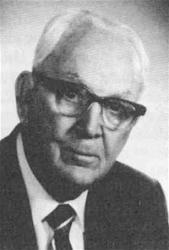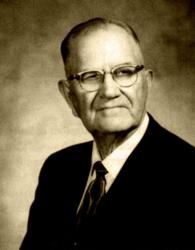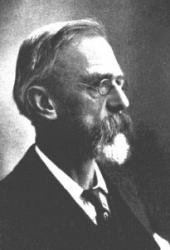Planning worship?
Check out our sister site, ZeteoSearch.org,
for 20+ additional resources related to your search.
- |
User Links
Person Results
Tillit S. Teddlie

1885 - 1987 Person Name: Tillit S. Tedley Topics: Jesus Christ Author of "Worthy of Praise" in Great Songs of the Church (Revised) Tillit Sidney Teddlie was born on June 3, 1885 at Swan, Texas. He was a leader in the Churches of Christ denomination in the 20th Century. In addition to singing schools which he taught for 61 years, he also preached and taught across Texas and the southwest. For one period of time (two years) he sang only with Foy E. Wallace, Jr., (a well-known, conservative Churches of Christ preacher around World War II) while they conducted meetings across the country.
Teddlie was honored by many people in many places. On June 2, 1985, 630 churches across the land proclaimed Sunday “Tillit S. Teddlie Day” and sang his songs. Teddlie had composed 130 songs and published 14 song books. One of his song books, "Golden Harvest Hymns" included 100 of his best-known hymns. He attended a song fest in his name at the Preston Crest Church of Christ in Dallas where more than 1,200 gathered. Teddlie's 100th birthday was honored by President Reagan who sent a telegram, and Sen. Phil Graham among others. The Briar, Texas, Church of Christ gave him a bronze statue worth $6,000.
His songs published in hymnals from Churches of Christ include “Worthy Art Thou,” “Heaven Holds All to Me,” “When We Meet in Sweet Communion, “Oft We Come Together,” “Singing Redemption’s Song,” “Hear Me When I Call,” “O God of Infinite Mercy,” and many more. While Teddlie had success as a publisher of many of his own smaller hymnals, his contributions as a composer to every major hymnal published in Churches of Christ since 1921 have left an indelible imprint on the denomination’s hymnody.
Teddlie died August 17, 1987 at the age of 102. He is remembered for his preaching, teaching, and music and his good influence upon all the people that he met and worked with.
D. J. Bulls, from "In Memoriam" by Gussie Lambert, 1988; "Our Garden of Song" by G. C. Finley, Howard Publishing, 1984; "Tillit S. Teddlie, A Centennial Celebration" Program, June 2, 1985, Dallas, TX, http://www.therestorationmovement.com/_states/texas/teddlie,ts.htm
Tillit S. Teddlie
John David Edwards
1805 - 1885 Person Name: John D. Edwards Topics: Jesus Christ Friend; Jesus Christ Passion and Cross Composer of "RHOSYMEDRE" in The New Century Hymnal Welsh composer; bardic name Penrhiwceibr.
John David Edwards (b. Penderlwyngoch, Cardiganshire, Wales, 1805; d. Llanddoget, Denbighshire, North Wales, 1885) was educated at Jesus College, Oxford, England, and ordained an Anglican priest in 1833. He served parishes in Rhosymedre and Llanddoget and published a collection of hymn tunes, Original Sacred Music (2 vols., 1836, 1843), for use in Anglican churches in Wales.
Bert Polman
John David Edwards
L. O. Sanderson

1901 - 1992 Person Name: Lloyd O. Sanderson Topics: The Gospel of Jesus Christ The Response Composer of "BURIED WITH CHRIST" in Great Songs of the Church (Revised) See also Vana R. Raye (pseudonym).
==================
Lloyd Otis Sanderson was born May 18, 1901 near Jonesboro, Arkansas. His father was a singing teacher. There were a variety of musical instruments in the home, so all of his children learned to sing and play instruments from early in life. He studied and taught music most of early teens and twenties and then began to serve churches for Churches of Christ.
Among Churches of Christ, L.O Sanderson is one of a handful of significant individuals who helped to codify the hymnody of this denomination in the early and mid 20th century. Dozens of his songs remain at the core of this group’s hymnody. As Musical Editor for the Gospel Advocate Company of Nashville during the hymnal heyday of the mid 20th century, Sanderson was responsible not only for the editing of a number of important hymnals, but for helping to shape the church’s song. He composed a number under the pen name of Vana Raye in tribute to his wife. As a composer of both lyrics and music, Sanderson collaborated with a number of individuals, the most notable being his friend, Thomas O. Chisholm, with whom he wrote “Be With Me, Lord,” perhaps his most popular hymn.
Dianne Shapiro, from Sanderson's autobiography (http://www.therestorationmovement.com/_states/tennessee/sanderson.htm) and D. J. Bulls
L. O. Sanderson
William S. Bambridge

1842 - 1923 Topics: Christ, The Lord Jesus Composer of "ST. ASAPH" in Trinity Hymnal
William S. Bambridge
Eliza Scudder
1821 - 1896 Topics: The Lord Jesus Christ Author of "Thou long disowned, reviled, oppressed" in Worship Song Scudder, Eliza , niece of Dr. E. H. Sears, (q.v.), was born in Boston, U.S.A., Nov. 14,1821, and now (1888) lives in Salem, Massachusetts. Formerly an Unitarian, she some time ago joined the Protestant Episcopal Church. Her hymns in common use are:—
1. From past regret and present[faithlessness] feebleness . Repentance. In the Quiet Hours, Boston, 1875.
2. I cannot find Thee! Still on restless pinion . Seeking after God. Appeared in Longfellow and Johnson's Unitarian Hymns of the Spirit, 1864.
3. In Thee my powers and treasures live. Faith.
4. Life of our life, and light of all our seeing! Prayer. In the Boston Quiet Hours, 1875.
5. The day is done; the weary day of thought and toil is past. Evening. In Sermons and Songs of the Christian Life, by E. H. Sears, Boston, 2nd ed.,1878, p. 296, entitled "Vesper Hymn," and dated "October, 1874." This is possibly her finest hymn.
6. Thou grace divine, encircling all . Divine Grace. Appeared in Dr. E. H. Sears's Pictures of the Olden Time, as shown in the Fortunes of a Family of Pilgrims, 1857. It was written in 1852, and included in the Boston Hymns of the Spirit, 1864. It has sometimes been taken as "An Ancient Catholic Hymn" (Universalist's Psalms & Hymns 1865), but in error.
7. Thou long disowned, reviled, oppresst. The Spirit of Truth. In the Boston Hymns of the Spirit, 1864.
Of these hymns, Nos. 2, 6, and 7 are in Dr. Martineau's Hymns, 1873. Some of Miss Scudder's poetical pieces appeared in Dr. Sears's Monthly Religious Magazine. Her Hymns and Sonnets, by E. S., were published by Lockwood, Brooks & Co., Boston, 1880. From this her hymn "Thou hast gone up again" (Ascension), is taken. [Rev. F. M. Bird, M.A.]
-- John Julian, Dictionary of Hymnology (1907)
====================
Scudder, Eliza, pp. 1035, L, 1589, i. Miss Scudder died in 1896. Her Hymns & Sonnets, with biographical notes, &c, by Horace E. Scudder, was published by Houghton & Mifflin, 1897. In The Pilgrim Hymnal, 1904, the hymn," Thou Life within my life," begins with st. ii. of "From past regret and present [faithlessness] feebleness," p. 1035, i. 1), which was written in Feb. 1871. Another of Miss Scudder's hymns is “ Let whosoever will enquire" (New Heaven), from which "My God, I rather look to Thee," in Horder's Worship Song, 1905, is taken.
--John Julian, Dictionary of Hymnology, New Supplement (1907)
Eliza Scudder
Charles Zeuner
1795 - 1857 Person Name: Charles Zeuner, 1795-1857) Topics: Jesus Christ Life, Ministry of Composer of "MISSIONARY CHANT" in The Christian Hymnary. Bks. 1-4 Also:
Zeuner, Heinrich Christoph, 1795-1857
Zeuner, Heinrich Christopher, 1795-1857
Charles Zeuner
Elizabeth Rundle Charles
1828 - 1896 Person Name: Elizabeth Charles, 1828-1896 Topics: God | The Lord Jesus Christ - His Sufferings and Death Author of "Never further than Thy Cross" in The Hymnary of the United Church of Canada Charles, Elizabeth, née Rundle, is the author of numerous and very popular works intended to popularize the history of early Christian life in Great Britain; of Luther and his times; of Wesley and his work; the struggles of English civil wars; and kindred subjects as embodied in the Chronicles of the Schönherg-Cotta Family, the Diary of Kitty Trevelyan, &c, was born at Tavistock, Devonshire, Her father was John Rundle, M.P., and her husband, Andrew Paton Charles, Barrister-at-Law. Mrs. Charles has made some valuable contributions to hymnology, including original hymns and translations from the Latin and German. These were given in her:—
(1) The Voice of Christian Life in Song; or, Hymns and Hymn-writers of Many Lands and Ages, 1858; (2) The Three Wakings, and other Poems, 1859; and (3) The Chronicles of the Schönberg-Cotta Family; (4) Poems, New York, 1867. This has some additional pieces.
Her hymn on the Annunciation, "Age after age shall call thee [her] blessed," appeared in her Three Wakings, &c., 1859.
--John Julian, Dictionary of Hymnology (1907)
=========================
Charles, Elizabeth, née Rundle. Mrs. Charles has assumed the name of "Rundle-Charles," as given in the 1890 edition of the Hymnal Companion. Other hymns in common use are:—
1. Around a Table, not a tomb. Holy Communion. Dated Oct. 1862. In her Poems, 1868, in 6 stanzas of 4 lines.
2. Come, and rejoice with me. Joy in Christ. Some-times dated 1846. From her Three Wakings, 1859, p. 146, in 7 stanzas of 4 lines, and headed "Eureka."
3. Jesus, what once Thou wast. Jesus the Unchangeable One. In Mrs. Brock's Children's Hymn Book, 1881.
4. Never further than Thy Cross. Passiontide. In The Family Treasury, Feb. 1860.
5. What marks the dawning of the Year? New Year. From her Three Wakings, 1859, p. 155.
--John Julian, Dictionary of Hymnology, Appendix, Part II (1907)
======================
Charles, Elizabeth, née Rundle, pp. 218, ii.; 1556, i. Mrs. Rundle-Charles was born Jan. 2, 1828, married in 1851, and died March 28, 1896. Her hymn, "The little birds fill all the air with their glee" (Thankfulness), was published in her Three Waitings, 1859, p. 165, as a "Song for an Infant School." It is found in The Sunday School Hymnary, 1905, and others. [Rev. James Mearns, M.A.]
--John Julian, Dictionary of Hymnology, New Supplement (1907)
Elizabeth Rundle Charles
Harry H. Beadle
1828 - 1902 Person Name: H. H. Beadle Topics: The Lord Jesus Christ Coming Again Composer of "VICTORY" in The New Laudes Domini Harry Hobart Beadle was born in Wallingford, Connecticut. He was a member of the South Congregational Church in Brooklyn and for nearly thirty years he served as organist and also as clerk. In 1861 what was known as the Carroll Guard was organized in the church. It became Company F of the Thirteenth Regiment. Beadle was the Second Lieutenant, then became Captain and then Colonel. He was President of the Thirteenth Regiment Veteran Association.
New York Times obituary, December 4, 1902
Harry H. Beadle
A. L. Peace

1844 - 1912 Person Name: Albert Lister Peace Topics: Jesus Christ Cross; Jesus Christ Images of; Jesus Christ Light; Jesus Christ Love of Composer of "ST. MARGARET" in Voices United Albert Lister Peace DMus United Kingdom 1844-1912. Born at Huddersfield, Yorkshire, England, son of a warehouseman and woolstapler, he was extremely gifted as a musician, largely self-taught, playing the organ at Holmfirth Parish Church near Huddersfield at age nine. He married Margaret Martin Steel Gilchrist, and they had three children: Lister, Archibald, and Margaret. In 1865 he was appointed organist of Trinity Congregational Church in Glasgow, Scotland. He obtained his doctorate degree from the University of Oxford in 1875. He became organist at Glasgow Cathedral in 1879. In 1897 he succeeded William Best as organist at St George’s Hall, Liverpool. In later years he was in much demand to play the organ in recitals. He did so at Canterbury Cathedral (1886), Victoria Hall, Hanley, Stoke-on-Trent (1888), and Newcastle Cathedral (1891). He composed orchestrations, sonatas, cantatas, and concert and church service anthems. He was an arranger, author, and editor. He died at Blundelsands, Liverpool, England.
John Perry
A. L. Peace


 My Starred Hymns
My Starred Hymns


